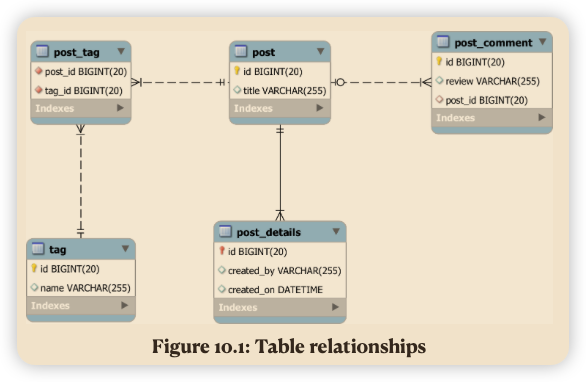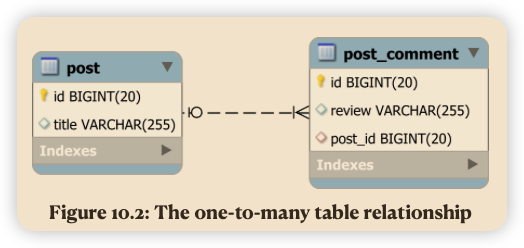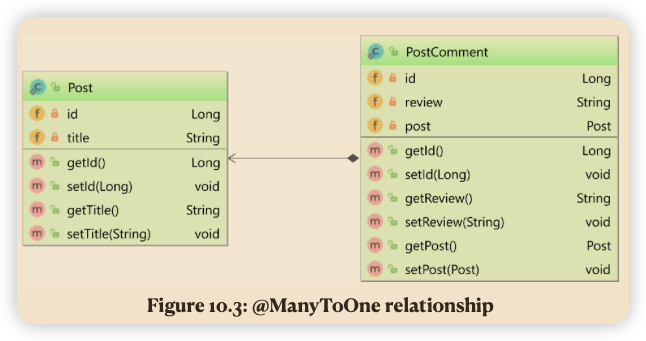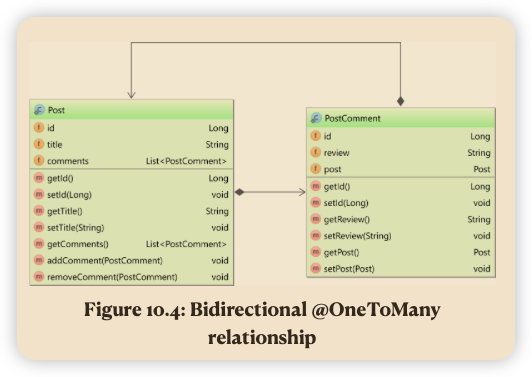High Performance Java Persistence
10. Relationships

JPA defines four association mapping constructs:
_ @ManyToOne represents the child-side (where the foreign key resides) in a database one-to-many table relationship. _ @OneToMany is associated with the parent-side of a one-to-many table relationship. _ @ElementCollection defines a one-to-many association between an entity and multiple value types (basic or embeddable). _ @OneToOne is used for both the child-side and the parent-side in a one-to-one table relationship. _ @ManyToMany mirrors a many-to-many table relationship.’
10.2 @ManyToOne
The @ManyToOne relationship is the most common’
foreign key is controlled by the child-side, no matter the association is unidirectional or bidirectional.
unidirectional @ManyToOne


10.3 @OneToMany
@ManyToOne이 most natural mapping
@OneToMany can also mirror this database relationship, but only when being used as a bidirectional mapping
unidirectional @OneToMany association uses an additional junction table, which no longer fits the one-to-many table relationship semantics.
10.3.1 Bidirectional @OneToMany
bidirectional @OneToMany association has a matching @ManyToOne child-side mapping

In a bidirectional association, only one side can control the underlying table relationship.
it is the child-side @ManyToOne association in charge of keeping the foreign key column value in sync with the in-memory Persistence Context
This is the reason why the bidirectional @OneToMany relationship must define the mappedBy attribute, indicating that it only mirrors the @ManyToOne child-side mapping
bidirectional association must always have both the parent-side and the child-side in sync.
To synchronize both ends, it is practical to provide parent-side helper methods that add/remove child entities.
major advantages of using a bidirectional association
entity state transitions can be cascaded from the parent entity to its children.
In the following example, when persisting the parent Post entity, all the PostComment child entities are persisted as well.
‘When removing a comment from the parent-side collection:
post.removeComment(comment1);‘The orphan removal attribute instructs Hibernate to generate a delete DML statement on the targeted child entity:
DELETE FROM post_comment WHERE id = 2’
10.3.2 Unidirectional @OneToMany
need for helper methods and the mapping does not feature a mappedBy attribute either.
not map to a one-to-many table relationship’
Hibernate uses a separate junction table to manage the association between a parent row and its child records.
joining three tables is less efficient than joining just two
Because there are two foreign keys, there need to be two indexes (instead of one), so the index memory footprint increases
problems
all junction table rows associated with the parent entity are deleted, and then the remaining in-memory records are added back again
database has way more DML
Another problem is related to indexes
10.3.3 Ordered unidirectional @OneToMany
If the collection can store the index of every collection element, the unidirectional @OneToMany relationship may benefit for some element removal operations
10.3.4 @OneToMany with @JoinColumn
With the @JoinColumn, the @OneToMany association controls the child table foreign key, so there is no need for a junction table.
Bidirectional @OneToMany with @JoinColumn relationship
The @OneToMany with @JoinColumn association can also be turned into a bidirectional relationship, but it requires instructing the child-side to avoid any insert and update synchronization:
@ManyToOne @JoinColumn(name = "post_id", insertable = false, updatable = false) private Post post;The redundant update statements are generated for both the unidirectional and the bidirectional association, so the most efficient foreign key mapping is the @ManyToOne association.
10.3.5 Unidirectional @OneToMany Set
Set을 이용하기 위해 hashCode와 equals 메소드를 구현해야 함
To avoid using a secondary table, the @OneToMany mapping can use the @JoinColumn annotation.
unidirectional Set is still less efficient than the bidirectional @OneToMany association.
10.4 @ElementCollection
@ElementCollection is very similar to the unidirectional @OneToMany relationship.
To represent collections of basic types (e.g. String, int, BigDecimal) or embeddable types, the @ElementCollection must be used instead.
10.4.1 @ElementCollection List
Using an @ElementCollection with a List is not very efficient because the association is considered to be a bag, in Hibernate terminology.
A bag does not guarantee that elements are uniquely identifiable, hence Hibernate needs to delete and reinsert the elements associated with a given parent entity whenever a change occurs to the @ElementCollection List.
10.4.2 @ElementCollection Set
On the other hand, when using a Set, the @ElementCollection no longer behaves like a bag, and the generated SQL statements are going to be more efficient.
10.5 @OneToOne
In JPA, the @OneToOne relationship can be either unidirectional or bidirectional.
10.5.1 Unidirectional @OneToOne
10.5.2 Bidirectional @OneToOne
10.6 @ManyToMany
10.6.1 Unidirectional @ManyToMany List
For @ManyToMany associations, CascadeType.REMOVE does not make too much sense when both sides represent independent entities.
10.6.2 Unidirectional @ManyToMany Set
10.6.3 Bidirectional @ManyToMany
10.6.4 The @OneToMany alternative
--- image path 변경